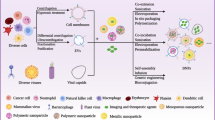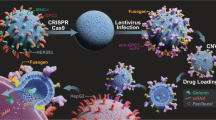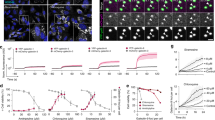Abstract
Nanotechnology offers many benefits, and here we report an advantage of applying RNA nanotechnology for directional control. The orientation of arrow-shaped RNA was altered to control ligand display on extracellular vesicle membranes for specific cell targeting, or to regulate intracellular trafficking of small interfering RNA (siRNA) or microRNA (miRNA). Placing membrane-anchoring cholesterol at the tail of the arrow results in display of RNA aptamer or folate on the outer surface of the extracellular vesicle. In contrast, placing the cholesterol at the arrowhead results in partial loading of RNA nanoparticles into the extracellular vesicles. Taking advantage of the RNA ligand for specific targeting and extracellular vesicles for efficient membrane fusion, the resulting ligand-displaying extracellular vesicles were capable of specific delivery of siRNA to cells, and efficiently blocked tumour growth in three cancer models. Extracellular vesicles displaying an aptamer that binds to prostate-specific membrane antigen, and loaded with survivin siRNA, inhibited prostate cancer xenograft. The same extracellular vesicle instead displaying epidermal growth-factor receptor aptamer inhibited orthotopic breast cancer models. Likewise, survivin siRNA-loaded and folate-displaying extracellular vesicles inhibited patient-derived colorectal cancer xenograft.
This is a preview of subscription content, access via your institution
Access options
Access Nature and 54 other Nature Portfolio journals
Get Nature+, our best-value online-access subscription
$29.99 / 30 days
cancel any time
Subscribe to this journal
Receive 12 print issues and online access
$259.00 per year
only $21.58 per issue
Buy this article
- Purchase on Springer Link
- Instant access to full article PDF
Prices may be subject to local taxes which are calculated during checkout






Similar content being viewed by others
References
Shu, D., Shu, Y., Haque, F., Abdelmawla, S. & Guo, P. Thermodynamically stable RNA three-way junctions for constructing multifuntional nanoparticles for delivery of therapeutics. Nat. Nanotech. 6, 658–667 (2011).
Zhang, H. et al. Crystal structure of 3WJ core revealing divalent ion-promoted thermostability and assembly of the Phi29 hexameric motor pRNA. RNA 19, 1226–1237 (2013).
Guo, P., Erickson, S. & Anderson, D. A small viral RNA is required for in vitro packaging of bacteriophage phi29 DNA. Science 236, 690–694 (1987).
Guo, P., Zhang, C., Chen, C., Trottier, M. & Garver, K. Inter-RNA interaction of phage phi29 pRNA to form a hexameric complex for viral DNA transportation. Mol. Cell. 2, 149–155 (1998).
Lamichhane, T. N., Raiker, R. S. & Jay, S. M. Exogenous DNA loading into extracellular vesicles via electroporation is size-dependent and enables limited gene delivery. Mol. Pharm. 12, 3650–3657 (2015).
Rak, J. Organ-seeking vesicles. Nature 527, 312–314 (2015).
Melo, S. A. et al. Glypican-1 identifies cancer exosomes and detects early pancreatic cancer. Nature 523, 177–182 (2015).
Witwer, K. W. et al. Standardization of sample collection, isolation and analysis methods in extracellular vesicle research. J. Extracell. Vesicles. 2, (2013).
Shelke, G. V., Lasser, C., Gho, Y. S. & Lotvall, J. Importance of exosome depletion protocols to eliminate functional and RNA-containing extracellular vesicles from fetal bovine serum. J. Extracell. Vesicles. 3, (2014).
Thery, C., Amigorena, S., Raposo, G. & Clayton, A. Isolation and characterization of exosomes from cell culture supernatants and biological fluids. Curr. Protoc. Cell Biol. Chapter 3, Unit 3.22 (2006).
Kumar, D., Gupta, D., Shankar, S. & Srivastava, R. K. Biomolecular characterization of exosomes released from cancer stem cells: possible implications for biomarker and treatment of cancer. Oncotarget 6, 3280–3291 (2015).
Bunge, A. et al. Lipid membranes carrying lipophilic cholesterol-based oligonucleotides: characterization and application on layer-by-layer coated particles. J. Phys. Chem. B 113, 16425–16434 (2009).
Pfeiffer, I. & Hook, F. Bivalent cholesterol-based coupling of oligonucletides to lipid membrane assemblies. J. Am. Chem. Soc. 126, 10224–10225 (2004).
Marcus, M. & Leonard, J. N. FedExosomes: engineering therapeutic biological nanoparticles that truly deliver. Pharmaceuticals (Basel) 6, 659–680 (2013).
van Dongen, H. M., Masoumi, N., Witwer, K. W. & Pegtel, D. M. Extracellular vesicles exploit viral entry routes for cargo delivery. Microbiol. Mol. Biol. Rev. 80, 369–386 (2016).
Parker, N. et al. Folate receptor expression in carcinomas and normal tissues determined by a quantitative radioligand binding assay. Anal. Biochem. 338, 284–293 (2005).
Dassie, J. P. et al. Targeted inhibition of prostate cancer metastases with an RNA aptamer to prostate-specific membrane antigen. Mol. Ther. 22, 1910–1922 (2014).
Rockey, W. M. et al. Rational truncation of an RNA aptamer to prostate-specific membrane antigen using computational structural modeling. Nucleic Acid Ther. 21, 299–314 (2011).
Binzel, D. et al. Specific delivery of MiRNA for high efficient inhibition of prostate cancer by RNA nanotechnology. Mol. Ther. 24, 1267–1277 (2016).
Hynes, N. E. & Lane, H. A. ERBB receptors and cancer: the complexity of targeted inhibitors. Nat. Rev. Cancer 5, 341–354 (2005).
Esposito, C. L. et al. A neutralizing RNA aptamer against EGFR causes selective apoptotic cell death. PLoS One 6, e24071 (2011).
Shu, D. et al. Systemic delivery of anti-miRNA for suppression of triple negative breast cancer utilizing RNA nanotechnology. ACS Nano 9, 9731–9740 (2015).
Paduano, F. et al. Silencing of survivin gene by small interfering RNAs produces supra-additive growth suppression in combination with 17-allylamino-17-demethoxygeldanamycin in human prostate cancer cells. Mol. Cancer Ther. 5, 179–186 (2006).
Khaled, A., Guo, S., Li, F. & Guo, P. Controllable self-assembly of nanoparticles for specific delivery of multiple therapeutic molecules to cancer cells using RNA nanotechnology. Nano Lett. 5, 1797–1808 (2005).
Cui, D. et al. Regression of gastric cancer by systemic injection of RNA nanoparticles carrying both ligand and siRNA. Sci. Rep. 5, 10726 (2015).
Lee, T. J. et al. RNA nanoparticles as a vector for targeted siRNA delivery into glioblastoma mouse model. Oncotarget 6, 14766–14776 (2015).
varez-Erviti, L. et al. Delivery of siRNA to the mouse brain by systemic injection of targeted exosomes. Nat. Biotechnol. 29, 341–345 (2011).
Ohno, S. et al. Systemically injected exosomes targeted to EGFR deliver antitumor microRNA to breast cancer cells. Mol. Ther. 21, 185–191 (2013).
Tian, Y. et al. A doxorubicin delivery platform using engineered natural membrane vesicle exosomes for targeted tumor therapy. Biomaterials 35, 2383–2390 (2014).
Hung, M. E. & Leonard, J. N. Stabilization of exosome-targeting peptides via engineered glycosylation. J. Biol. Chem. 290, 8166–8172 (2015).
Binzel, D. W., Khisamutdinov, E. F. & Guo, P. Entropy-driven one-step formation of Phi29 pRNA 3WJ from three RNA fragments. Biochemistry 53, 2221–2231 (2014).
Haque, F. et al. Ultrastable synergistic tetravalent RNA nanoparticles for targeting to cancers. Nano Today 7, 245–257 (2012).
Li, Y., Tian, Z., Rizvi, S. M., Bander, N. H. & Allen, B. J. In vitro and preclinical targeted alpha therapy of human prostate cancer with Bi-213 labeled J591 antibody against the prostate specific membrane antigen. Prostate Cancer Prostatic Dis. 5, 36–46 (2002).
Pettaway, C. A. et al. Selection of highly metastatic variants of different human prostatic carcinomas using orthotopic implantation in nude mice. Clin. Cancer Res. 2, 1627–1636 (1996).
Rimawi, M. F. et al. Epidermal growth factor receptor expression in breast cancer association with biologic phenotype and clinical outcomes. Cancer 116, 1234–1242 (2010).
Pecot, C., Calin, G. A., Coleman, R. L., Lopez-Berestein, G. & Sood, A. K. RNA interference in the clinic: challenges and future directions. Nat. Rev. Cancer 11, 59–67 (2011).
El Andaloussi, S., Mager, I., Breakefield, X. O. & Wood, M. J. Extracellular vesicles: biology and emerging therapeutic opportunities. Nat. Rev. Drug Discov. 12, 347–357 (2013).
Valadi, H. et al. Exosome-mediated transfer of mRNAs and microRNAs is a novel mechanism of genetic exchange between cells. Nat. Cell Biol. 9, 654–659 (2007).
El Andaloussi, S., Lakhal, S., Mager, I. & Wood, M. J. Exosomes for targeted siRNA delivery across biological barriers. Adv. Drug Deliv. Rev. 65, 391–397 (2013).
van Dommelen, S. M. et al. Microvesicles and exosomes: opportunities for cell-derived membrane vesicles in drug delivery. J. Control Release 161, 635–644 (2012).
Wiklander, O. P. et al. Extracellular vesicle in vivo biodistribution is determined by cell source, route of administration and targeting. J. Extracell. Vesicles 4, 26316 (2015).
Guo, P. The emerging field of RNA nanotechnology. Nat. Nanotech. 5, 833–842 (2010).
Shu, D., Khisamutdinov, E., Zhang, L. & Guo, P. Programmable folding of fusion RNA complex driven by the 3WJ motif of phi29 motor pRNA. Nucleic Acids Res. 42, e10 (2013).
Varkouhi, A. K., Scholte, M., Storm, G. & Haisma, H. J. Endosomal escape pathways for delivery of biologicals. J. Control Release 151, 220–228 (2011).
Kilchrist, K. V., Evans, B. C., Brophy, C. M. & Duvall, C. L. Mechanism of enhanced cellular uptake and cytosolic retention of MK2 inhibitory peptide nano-polyplexes. Cell. Mol. Bioeng. 9, 368–381 (2016).
Jasinski, D., Schwartz, C., Haque, F. & Guo, P. Large scale purification of RNA nanoparticles by preparative ultracentrifugation. Methods Mol. Biol. 1297, 67–82 (2015).
Acknowledgements
We thank H. G. Zhang for his communication during the investigation of the exosome project, and J. Zhang, H. Weiss, D. Wu and D. Gao for assistance with statistical analysis. The research was supported mainly by National Institutes of Health grants UH3TR000875 and U01CA207946 (P. G.), and partially by R01CA186100 (B. G.), R35CA197706 (C.M.C.), P30CA177558 and R01CA195573 (B.M.E.).
Author information
Authors and Affiliations
Contributions
P.G. generated the original idea of using the 3WJ structure orientation to control cell entry or cell surface anchoring, respectively, and designed the arrowhead and arrowtail technology. P.G. and F.P. conceived and designed the experiments. H.L. and S.W. developed the method for RNA insertion to EV. F.P., H.L., D.W.B. and Z.L. performed the experiments. M.S. and B. Guo performed the prostate cancer mouse studies. T.J.L. performed the breast cancer mouse studies. P.R. performed the colorectal cancer mouse studies. P.G. and F.H. supervised the project. P.G., C.M.C. and B.M.E. provided the funding and resources. P.G., F.P., F.H. and D.W.B. co-wrote the manuscript, and all authors refined the manuscript.
Corresponding author
Ethics declarations
Competing interests
P.G.’s Sylvan G. Frank Endowed Chair position in Pharmaceutics and Drug Delivery is funded by the CM Chen Foundation, and he is a consultant of Oxford Nanopore, Nanobio Delivery Pharmaceutical Co., Ltd, and the cofounder of P&Z Biological Technology LLC. F.P. now works for Nanobio Delivery Pharmaceutical Co., Ltd. S.W. and F.H. now work for P&Z Biological Technology LLC.
Additional information
Publisher’s note: Springer Nature remains neutral with regard to jurisdictional claims in published maps and institutional affiliations.
Supplementary information
Supplementary Information
Supplementary figures and figure legends.
Rights and permissions
About this article
Cite this article
Pi, F., Binzel, D.W., Lee, T.J. et al. Nanoparticle orientation to control RNA loading and ligand display on extracellular vesicles for cancer regression. Nature Nanotech 13, 82–89 (2018). https://doi.org/10.1038/s41565-017-0012-z
Received:
Accepted:
Published:
Issue Date:
DOI: https://doi.org/10.1038/s41565-017-0012-z
This article is cited by
-
Tumor-derived small extracellular vesicles in cancer invasion and metastasis: molecular mechanisms, and clinical significance
Molecular Cancer (2024)
-
Generalizable anchor aptamer strategy for loading nucleic acid therapeutics on exosomes
EMBO Molecular Medicine (2024)
-
Non-small cell lung cancer targeted nanoparticles with reduced side effects fabricated by flash nanoprecipitation
Cancer Nanotechnology (2023)
-
CircZNF215 promotes tumor growth and metastasis through inactivation of the PTEN/AKT pathway in intrahepatic cholangiocarcinoma
Journal of Experimental & Clinical Cancer Research (2023)
-
Targeted therapy using engineered extracellular vesicles: principles and strategies for membrane modification
Journal of Nanobiotechnology (2023)



